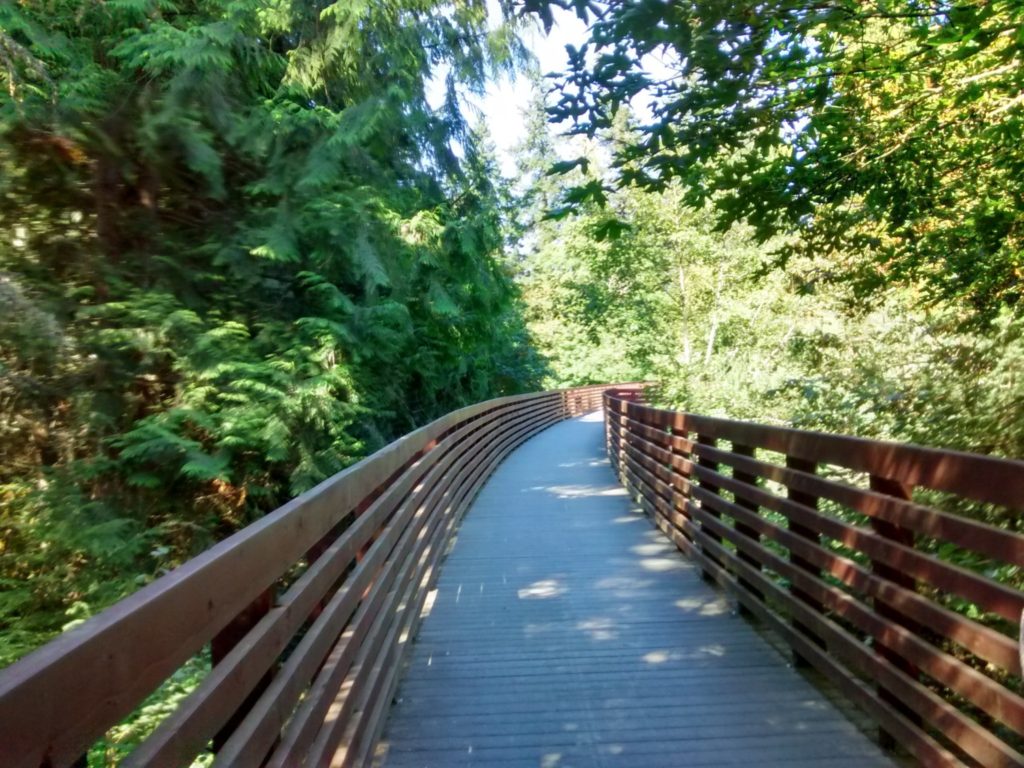
September 12, 2016
By Dorothy Rice Bennett
Before I moved to Sequim, Washington, in 2010, I visited several times. One of the first places that friends took me—to experience the “secret” gems of Sequim—was the Railroad Bridge Park, which features a wooden bridge spanning the Dungeness River.
I was suitably impressed by the bridge and the river. “Dungeness,” I have learned, is a big word around here: Dungeness River, Dungeness Refuge, Dungeness Spit, New Dungeness Lighthouse, and Dungeness crab. In summer, the river under the bridge is a small stream bubbling over rocks and around curves and lined with tall trees. In the winter and spring, the Dungeness can roar under the bridge with a strong flow. Salmon swim upstream from the Straits of Juan de Fuca to spawn and can be seen performing their annual ritual in the moving waters below the bridge.
From railroad to hiking trail
While the bridge is beautiful, I didn’t understand its full significance until I learned a bit of local history. During the last century, trains ran across the Olympic Peninsula carrying a variety of products, including logs cut from the area forests. But as trucking via the 101 Highway took over the transportation of goods, railroads here were abandoned. And the unused railroad right of way gave birth to a new idea: the Olympic Discovery Trail—nearly 130 miles of paved hiking and biking trail from Port Townsend on the Admiralty Inlet of the Puget Sound to La Push on the Pacific Ocean. The trail hasn’t yet been completed, but there are large sections of it in daily use in and near Sequim and in Port Angeles and in some parts of the Olympic National Park. Paved in asphalt and eight feet wide, with periodic parking areas at posted “trailheads,” the Olympic Discovery Trail serves thousands of local residents and visitors as well.
Sequim has two landmark sections of the trail that are particular exciting to explore. One is—yes, you guessed it—the Railroad Bridge over the Dungeness River. The second is a long, curving trestle over the smaller Johnson Creek, which runs downhill through the John Wayne Marina and empties into Sequim Bay.
Both of these landmarks are part of what I call Sequim’s “secrets,” because neither is particularly visible. To reach the railroad bridge, you follow signs from Sequim’s Washington Street back into a forested area by the river and wind around curves until suddenly the bridge is in front of you. (Another entrance from the west end of the park also involves a considerable hike before you can see the bridge.) The Johnson Creek Trestle stands only a few feet from Highway 101 but is hidden in a grove of old forest growth and therefore invisible from the highway or from Whitefeather Way, which runs from the 101 downhill to the John Wayne Marina at water’s edge of Sequim Bay.
Bridge and trestle
The railroad bridge was built in 1915 by The Milwaukee Road and today is considered the “heart” of the Olympic Discovery Trail. Unfortunately, a violent winter storm in February 2015 almost brought the magic of this bridge to an end. Although the bridge structure was spared, the walkway approaching from the west was severely damaged, along with much of the old forest growth by the Dungeness at that point. The Jamestown S’Klallam Tribe, which owns the land on which the park is built, was able to borrow funds, and after several months, the bridge trestle was reopened to the public. During the rebuilding phase, the Railroad Bridge Park celebrated its 100th birthday.
The Johnson Creek Trestle, 410 feet long, is the longest trestle on the Olympic Peninsula, and from the top, visitors look down 86 feet toward the trestle’s support beams and the creek below. Built in 1914, the trestle saw its last train in 1983. Repurposed by a group of volunteers for use by the Olympic Discovery Trail, it is today well maintained. With a beautiful curving line, the trestle is one of Sequim’s amazing “secrets.”
Both the railroad bridge and the Johnson Creek trestle are wonderful to visit and explore. Both are surrounded by forest growth. From both you can feel the stillness of nature and listen to the soothing flow of water beneath. Both are healing to the spirit and worth many a repeat visit.
See you there, sometime soon.

